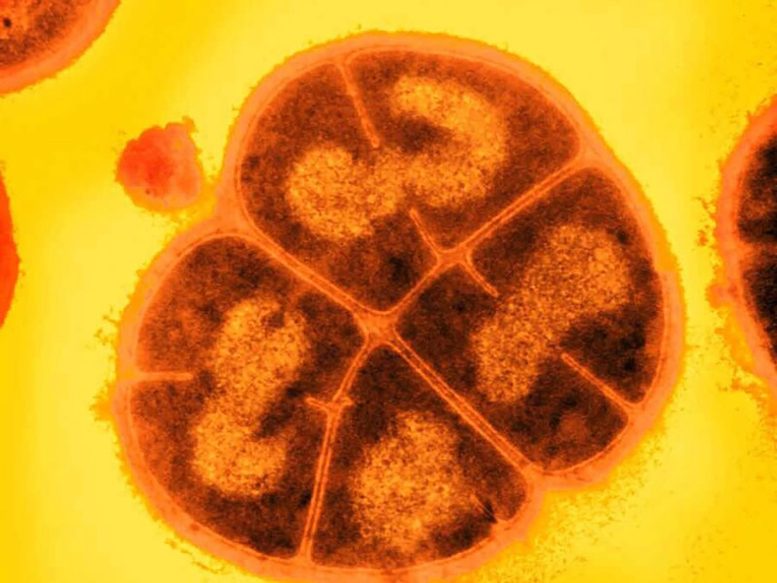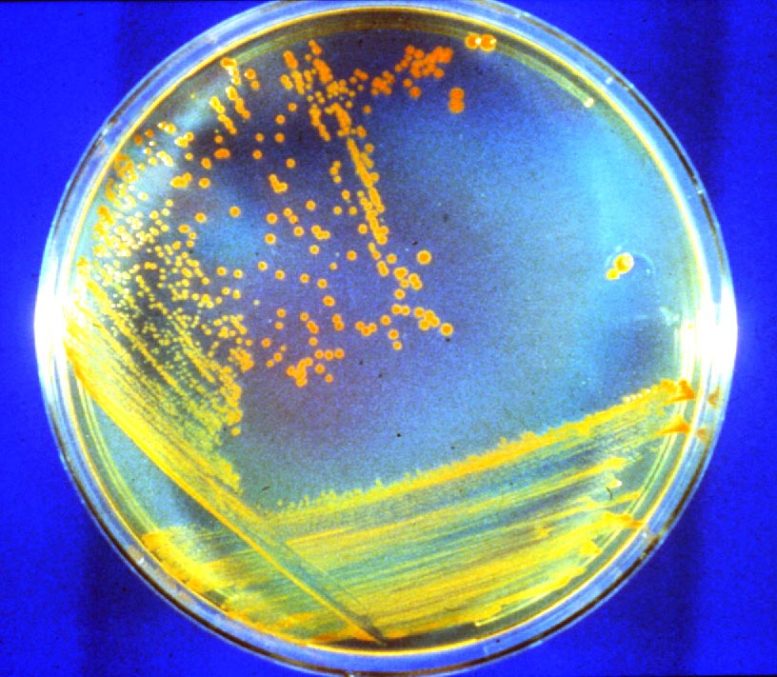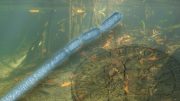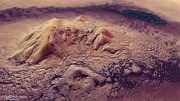
Deinococcus radiodurans (affectionately known as “Conan the Bacterium”) is particularly well-suited to surviving Mars’ harsh environment. In experiments, it survived astronomical amounts of radiation in the freezing, arid environment. Credit: Michael J. Daly/USU
A new study finds the chances of uncovering life on Mars are better than previously expected.
- Researchers simulated Mars’ harsh ionizing radiation conditions to see how long dried, frozen bacteria and fungi could survive.
- Previous studies found ‘Conan the Bacterium’ (Deinococcus radiodurans) could survive over a million years in Mars’ harsh ionizing radiation.
- A new study shatters that record, finding the hearty bacterium could survive 280 million years if buried.
- This means evidence of life could still be dormant and buried below Mars’ surface.
When the first samples from Mars are returned to Earth, scientists should be on the lookout for ancient sleeping bacteria, according to the findings of a new study.
In a first-of-its-kind study, a team of researchers has found that ancient bacteria could survive close to the surface on Mars much longer than previously assumed. Furthermore, they can survive much longer when the bacteria are buried and, thus, shielded from galactic cosmic radiation and solar protons.
These findings strengthen the possibility that if life ever evolved on Mars, its biological remains might be revealed in future missions. These future missions include ExoMars (Rosalind Franklin rover) and the Mars Life Explorer, which will carry drills to extract materials from 2 meters below the surface.
Because the scientists proved that certain strains of bacteria can survive despite Mars’ harsh environment, this also means that future astronauts and space tourists could inadvertently contaminate Mars with their own hitchhiking bacteria.
The paper will be published today (October 25) in the journal Astrobiology. The research team included Northwestern University’s Brian Hoffman and Ajay Sharma.

Deinococcus radiodurans (affectionately known as “Conan the Bacterium”) is particularly well-suited to surviving Mars’ harsh environment. In experiments, it survived astronomical amounts of radiation in the freezing, arid environment. Credit: Michael J. Daly/USU
“Our model organisms serve as proxies for both forward contamination of Mars, as well as backward contamination of Earth, both of which should be avoided,” said Michael Daly, a professor of pathology at Uniformed Services University of the Health Sciences (USU) and member of the National Academies’ Committee on Planetary Protection, who led the study. “Importantly, these findings have biodefense implications, too, because the threat of biological agents, such as Anthrax, remains a concern to military and homeland defense.”
“We concluded that terrestrial contamination on Mars would essentially be permanent — over timeframes of thousands of years,” said Hoffman, a senior co-author of the study. “This could complicate scientific efforts to look for Martian life. Likewise, if microbes evolved on Mars, they could be capable of surviving until present day. That means returning Mars samples could contaminate Earth.”
Hoffman is the Charles E. and Emma H. Morrison Professor of Chemistry and professor of molecular biosciences in Northwestern’s Weinberg College of Arts and Sciences. He also is a member of the Chemistry of Life Processes Institute.
Simulating Mars
Mars has a harsh and unforgiving environment. The arid and freezing conditions, which average -80 degrees Fahrenheit (-63 degrees Celsius) at mid-latitudes, make the Red Planet seem inhospitable to life. Even worse: Mars is also constantly bombarded by intense galactic cosmic radiation and solar protons.
To explore whether or not life could survive in these conditions, Daly, Hoffman, and their collaborators first determined the ionizing radiation survival limits of microbial life. Then, they exposed six types of Earthling bacteria and fungi to a simulated Martian surface — which is frozen and dry — and zapped them with gamma rays or protons (to mimic radiation in space).
“There is no flowing water or significant water in the Martian atmosphere, so cells and spores would dry out,” Hoffman said. “It also is known that the surface temperature on Mars is roughly similar to dry ice, so it is indeed deeply frozen.”
Ultimately, the researchers determined that some terrestrial microorganisms potentially could survive on Mars over geologic timescales of hundreds of millions of years. In fact, the scientists discovered that one specific robust microbe, Deinococcus radiodurans (affectionately known as “Conan the Bacterium”), is particularly well-suited to surviving Mars’ harsh conditions. In the novel experiments, Conan the Bacterium survived astronomical amounts of radiation in the freezing, arid environment — far outlasting Bacillus spores, which can survive on Earth for millions of years.
Radical radiation
To test the effects of radiation, the team exposed samples to large doses of gamma radiation and protons — typical to what Mars receives in the near subsurface — and far smaller doses, which would occur if a microorganism was deeply buried.
Then, Hoffman’s team at Northwestern used an advanced spectroscopy technique to measure the accumulation of manganese antioxidants in the radiated microorganisms’ cells. According to Hoffman, the size of the radiation dose that a microorganism or its spores can survive correlates with the amount of manganese antioxidants it contains. Therefore, more manganese antioxidants means more resistance to radiation — and more enhanced survival.
In earlier studies, previous researchers found that Conan the Bacterium, when suspended in liquid, can survive 25,000 units of radiation (or “grays”), the equivalent of about 1.2 million years just below Mars’ surface. But the new study found that when the hearty bacterium is dried, frozen, and deeply buried— which would be typical to a Martian environment — it could weather 140,000 grays of radiation. This dose is 28,000 times greater than what would kill a human.
Although Conan the Bacterium could only survive for a few hours at the surface while bathed in ultraviolet light, its lifetime improves dramatically when its shaded or located directly below Mars’ surface. Buried just 10 centimeters below the Martian surface, Conan the Bacterium’s survival period increases to 1.5 million years. And, when buried 10 meters down, the pumpkin-colored bacterium could survive a whopping 280 million years.
Looking to future missions
This astonishing survival feat is partially thanks to the bacterium’s genomic structure, the researchers found. Long suspected, the researchers discovered that Conan the Bacterium’s chromosomes and plasmids are linked together, keeping them in perfect alignment and ready for repair after intense radiation.
That means that if a microbe, similar to Conan the Bacterium, evolved during a time when water last flowed on Mars, then its living remains could still be dormant in the deep subsurface.
“Although D. radiodurans buried in the Martian subsurface could not survive dormant for the estimated 2 to 2.5 billion years since flowing water disappeared on Mars, such Martian environments are regularly altered and melted by meteorite impacts,” Daly said. “We suggest that periodic melting could allow intermittent repopulation and dispersal. Also, if Martian life ever existed, even if viable lifeforms are not now present on Mars, their macromolecules and viruses would survive much, much longer. That strengthens the probability that, if life ever evolved on Mars, this will be revealed in future missions.”
Reference: “Effects of desiccation and freezing on microbial ionizing radiation survivability: Considerations for Mars sample-return” by William H. Horne, Robert P. Volpe, George Korza, Sarah DePratti, Isabel H. Conze, Igor Shuryak, Tine Grebenc, Vera Y. Matrosova, Elena K. Gaidamakova, Rok Tkavc, Ajay Sharma, Cene Gostinčar, Nina Gunde-Cimerman, Brian M. Hoffman, Peter Setlow and Michael J. Daly, 31 October 2022, Astrobiology.
DOI: 10.1089/ast.2022.0065
The study was supported by the Defense Threat Reduction Agency (grant number HDTRA1620354) and the National Institutes of Health (grant number GM111097).









I think, if we get to dig deeper, that we will find that Mars was like a huge Buc-ee’s in ancient times… the last stop for the interstellar aliens to buy souvenirs, go to the bathroom and fill up with anti-matter before the proceeded onward to Earth.
Dr. Michael A. Smith andvI have already photographed Fossils (oncolites, sponges and Sponge spicules) and extant microbes in the sediment on Mars. 10-25-2022
Can you provide us a scientific reference to support that statement?
This kind of thinking is absurd. For life to exist on Mars it had to first evolve from primitive amino acids and form stable peptide and polypeptide bonds that need water but cannot be done underwater. The same is true for nucleotide and oligonucleotide bonds. That process must be done on land. What happens to life after that is a different topic entirely.
So in all the time rivers have been there and seen cliffs that should have layers going back far enough to tell if there was life… Why have they not studied those layers like they do in Earth?
So in all the time rovers have been there and seen cliffs that should have layers going back far enough to tell if there was life… Why have they not studied those layers like they do on Earth?
Sorry typo and no edit option… Annoying
Pah, the chances of anything coming from Mars are a million to one!
I’m sure I heard that mentioned somewhere 🙂